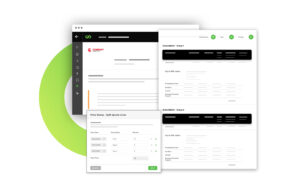Multi Year Deals Need Structured Ramp Pricing to Ensure Forecast Accuracy

Multi-year deals are meant to create revenue stability—but manual quoting often leads to messy data, misaligned forecasts, and disappearing margins. Embedding native ramp pricing into CPQ structures pricing by year or quarter, delivering predictable revenue, cleaner forecasts, and fewer financial surprises.
Why Multi-Year Deals Often Create Forecast Confusion
Multi-year contracts should bring predictability, but in many SaaS organizations, they do the opposite:
- Messy quote data that duplicates line items for each year
- Misaligned revenue assumptions in CRM and forecasts
- Margins that disappear due to untracked Year 2 or Year 3 discounts
- Forecasts built on shaky ground, leaving Finance guessing
The irony is clear: the deals meant to stabilize revenue often undermine it.
The Core Problem: Manual Multi-Year Deal Structures Break Predictability
When reps build multi-year deals manually:
- Line items are duplicated to mimic pricing changes
- Total deal values are skewed or misrepresented
- Approval thresholds apply to the wrong totals
- Forecast accuracy drops as Finance relies on assumptions
Your strategic revenue engine is running—but your deal data is still stuck in spreadsheet logic.
How Native Ramp Pricing in CPQ Fixes the Problem
Ramp pricing built into CPQ allows multi-year and multi-period deals to be structured with clarity:
- Products split across billing periods (Year 1–3, or Q1–Q4)
- Discounting logic applies per period based on internal rules
- Quotes auto-roll into CRM, segmented by billing periods
- Revenue teams gain visibility into how and when revenue is recognized
Everything becomes reportable, auditable, and aligned with finance workflows.
What RevOps and Finance Gain
- Reliable pipeline and renewal data that reflects real revenue timing
- Clean quote-to-forecast alignment with no manual reconciliation
- Fewer margin and revenue surprises in Years 2 and 3
- Stronger collaboration across Sales, Finance, and Customer Success
When price ramps are structured into the deal, not added as an afterthought, revenue becomes scalable, not guessable.
Manual Multi-Year Quoting vs CPQ Ramp Pricing
Feature | Manual Multi-Year Quoting | CPQ Ramp Pricing |
Forecast Accuracy | Low, based on assumptions | High, aligned with billing periods |
Margin Visibility | Inconsistent across years | Clear by period and deal structure |
Approval Confidence | Weak, prone to errors | Strong, rule-based and transparent |
Quote-to-CRM Alignment | Manual, error-prone | Automated, segmented by billing periods |
Audit & Revenue Recognition | Complex and risky | Reportable and audit-ready |
Frequently Asked Questions (FAQs)
What is ramp pricing in CPQ for multi-year deals?
It’s a structured pricing method where product and discount logic are applied per billing period, enabling accurate forecasts and revenue recognition.
Why do manual multi-year quotes cause forecast issues?
Because duplicating line items and manual edits create misaligned totals, incorrect assumptions, and messy data for Finance.
How does ramp pricing improve revenue predictability?
It ties quote logic directly to billing periods, ensuring your forecast reflects real revenue timing and margin impact.
Can this approach reduce margin erosion in future years?
Yes. Ramp pricing enforces discount rules and provides clear visibility into Year 2 and Year 3 pricing.
How does this benefit RevOps teams?
It delivers cleaner data, better cross-functional alignment, and reliable pipeline-to-renewal visibility.
Related Posts

Price Ramping Maximizes Lifetime Value with Scalable Pricing
Price Ramping Maximizes Lifetime Value with Scalable Pricing Instead of locking customers into flat rates, Price Ramping lets you build subscription contracts that grow over time. By aligning pricing with customer value and usage maturity, you remove friction from deal closure while expanding revenue predictably. This feature is crucial for

Stop Training Reps on Product Rules—Let CPQ Do It For You
Stop Training Reps on Product Rules—Let CPQ Do It For You Reps Shouldn’t Memorize Product Rules—They Should Sell If you’re constantly teaching reps what they can’t quote, you’ve got a tooling issue—not a training one. With CPQ product rule automation, reps quote faster, avoid errors, and learn configurations as they

Renewal Based Upselling Turns Every Contract into a Growth Moment
Renewal Based Upselling Turns Every Contract into a Growth Moment Most SaaS companies treat renewals as a checkbox—but that’s a missed revenue opportunity. Renewal-based upselling embeds upgrade options directly into renewal workflows, driving higher ACV, better customer satisfaction, and faster upsell cycles. The key? Use contextual visibility, pre-built upgrade paths,
Ready to fix leaks, speed up quoting, and unlock hidden revenue?
Use our RoI Calculator to see where your business can grow next.


